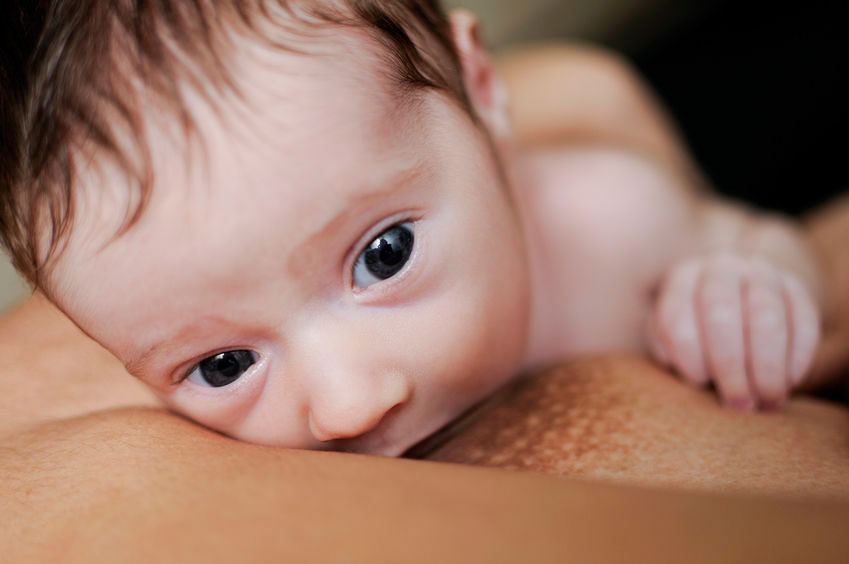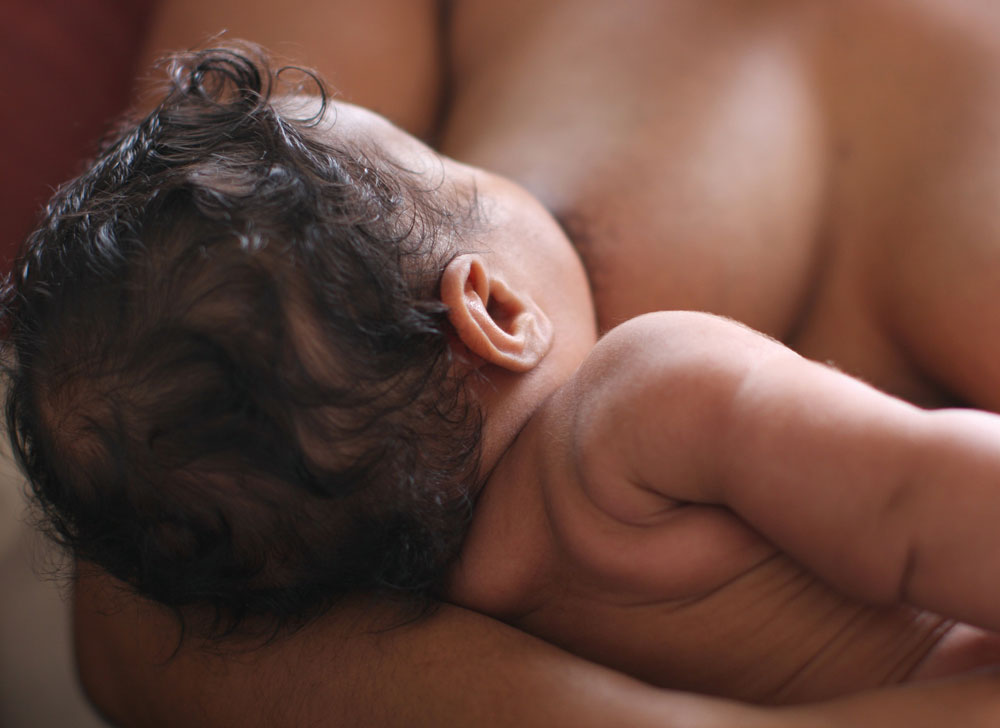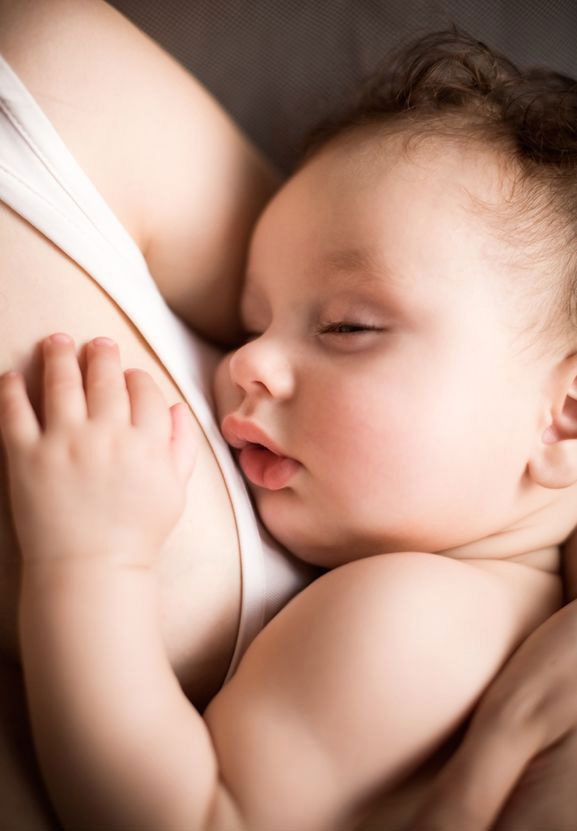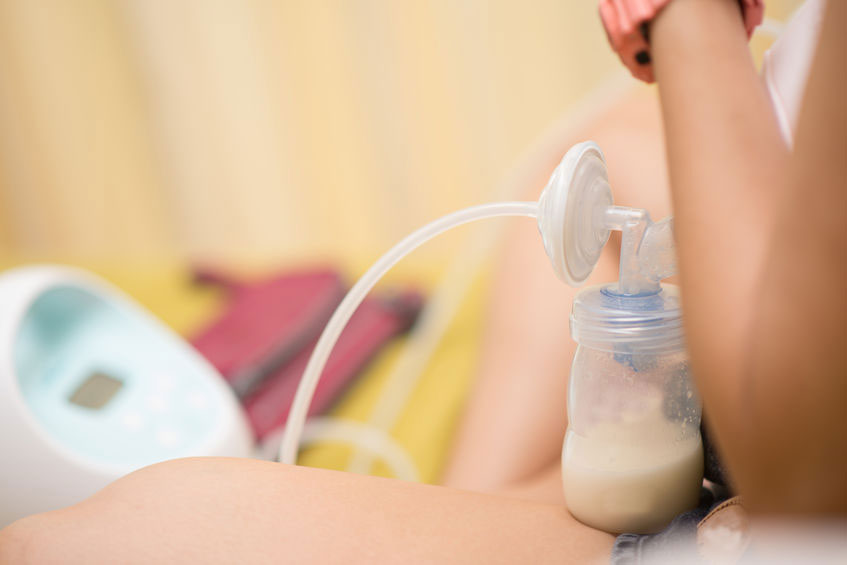There are several possible causes of sore nipples when a mother is breastfeeding. The most common reason is a baby who is not latched (attached) to the breast properly. To avoid sore nipples a baby needs plenty of breast tissue as well as the nipple in his mouth when he breastfeeds. However sometimes, positioning and attachment may look good yet a mother may still have very painful sore nipples. This article provides a brief guide to some common causes of sore nipples when breastfeeding.

Causes of sore nipples
#1 Position and attachment
When a baby breastfeeds with a big or deep mouthful of breast tissue as well as the nipple in their mouth it is often called a deep latch. Conversely, if a baby is mostly attached to the nipple with very little breast tissue this is known as a shallow latch. A deep latch is the goal. A shallow latch can cause painful feeds and blistered, cracked, grazed or bleeding nipples. Once a baby is helped to latch more deeply; sore or cracked nipples can usually heal quickly on their own. See Why Does Breastfeeding Hurt?, Breastfeeding Positions for Newborns, Latching Tips and Breastfeeding Videos for more information on position and attachment or contact a breastfeeding specialist to help you find a comfortable position to prevent sore nipples.
#2 Variations in anatomy (mother)
Sometimes a baby’s latch can “look” good but the mother complains of severe discomfort or one or both of her nipples are sore and damaged. If there is pain, something is not quite right whatever the latch looks like. Variations in the particular anatomy of mother or baby can sometimes make it harder to get comfortable. In these cases, an assessment by an IBCLC lactation consultant can be really helpful. Challenges can include:
- Nipple size and shape. Nipples come in many shapes and sizes and a mother can have two very differently shaped nipples. Very large, flat, inverted or unusually shaped nipples can sometimes rub in an infants mouth despite paying careful attention to positioning and attachment. See Breastfeeding With Inverted Nipples and Flat Nipples for help with flatter nipples and ask your breastfeeding specialist to assist with finding the best position for you and your baby. In some situations nipple shields (silicone nipple covers with holes for milk to flow) may be helpful. Dimpled or folded nipples may tend to trap moisture after a feed and become sore; patting them dry after a feed can avoid this.
- Large breasts. A larger cup size can sometimes make positioning more challenging see Breastfeeding With Large Breasts.
- Breast or nipple surgery. Previous surgeries may make nipples more sensitive or conversely there may be a loss of sensitivity making it difficult for a mother to recognise when a baby is not latched comfortably.

#3 Variations in anatomy (baby)
Just as mothers are all different, so are babies. Examples of variations in anatomy that could affect positioning and be causes of sore nipples include:
Small mouth
Sometimes a baby may seem too small for the size of the nipple or breast they are paired with making it more difficult for them to get a deeper latch. Sometimes a baby may not seem to be able to open their mouth wide enough. Positioning help from a breastfeeding specialist can often help mother and baby find a position that works for them and in a short period of time baby will grow in size.
Receding chin
A receding chin describes a small chin set back a little into the face and is quite normal in babies. However if the lower jaw is very much shorter than usual this can sometimes make it more difficult to get a deeper latch. Cathy Watson Genna 1 explains that a small lower jaw (micrognathia) can give a baby less strength in the jaw and restricted tongue movements. Small jaws tend to grow forward in time, often by around 12 weeks of age. In the mean time, mothers can explore:
- Paying careful attention to latch and positioning. Reclining or side-lying positions can be helpful
- A nipple shield may be useful short term
- Finger-feeding may help to strengthen tongue movements (Watson Genna, 2017)
Tongue function
Sometimes a baby pinches or grazes his mother’s nipples even though the latch “looks” good to an onlooker. This could have various causes including:
- Poor attachment—a deeper latch with more breast tissue in the mouth will stabilise the tongue and ensure the nipple is in a comfortable position in baby’s mouth.
- Tension—a baby may have high muscle tone e.g. tension in the neck, jaw or muscles controlling the tongue which can prevent a full range of movement.
- Nipple confusion—a baby who is used to a bottle teat may be using a bottle feeding technique at the breast—sometimes called nipple confusion—see Tips to Bottle Feed a Breastfed Baby for more reading.
- Pinching to control fast flow—if milk flow is very fast or there is frequently too much milk available, a baby may also learn to pinch the nipples to stem the flow of breast milk. See What is a Fast Let-Down? and Oversupply of Breast Milk for more reading.
- Tongue-tie—this is when a baby has restricted tongue movements due to the anatomy under their tongue. See What is a Tongue-Tie? for more information.
An IBCLC lactation consultant can help to find solutions if you feel your baby’s sucking technique is a cause of sore nipples.

#4 Pumping equipment
The part of the pump that rests against the breast is called a flange and includes a narrow nipple tunnel which is held over your nipple. If the nipple tunnel is too small or too large this can cause sore or damaged nipples. If the pump vacuum is too high this can also cause trauma to the nipples. See How to Increase Milk Supply When Pumping and the Flange FITS™ Guide from Babies in Common for help in choosing the right sized nipple tunnel. Some mothers have found moulded silicone breast pumps to be a comfortable alternative to a regular manual or electric pump if they have damaged nipples.
#5 Vasopasm of the nipple
A vasospasm is a sudden constriction (vasoconstriction) or narrowing of the blood vessels. When it happens in the nipple, it can be extremely painful. If you have a nipple vasospasm you may notice blanching of the nipples (when the tips of the nipples look white after a feed) and the pain may be felt a short time after breastfeeding or in between feeds. Possible causes of nipple vasospasm include;
- A shallow latch—getting your baby latched deeply at the breast will be helpful
- Raynaud’s phenomenon—this is a condition where the mother may experience similar symptoms in her fingers and toes, often triggered by feeling cold
- Stress
- Exposure to cigarette smoke
- Certain medical conditions.
Vasopasm or vasoconstriction of the nipple can also cause Mammary Constriction Syndrome (deep breast and muscle pain). See Vasospasm Symptoms for more information on causes, symptoms and treatments for nipple blanching and vasospasm.
#6 Nipple dermatitis, eczema and psoriasis
The skin conditions dermatitis, eczema and psoriasis are possible causes of sore, inflamed nipples.
- Sensitivity to topical creams. Nipple dermatitis (inflamed, irritated nipples) may be due to an allergy to a cream or remedy that mothers may be using on their nipples. Even purified lanolin—a popular choice for soothing nipples—can cause a reaction in some mothers, either as an allergy or by causing moisture associated skin damage.2
- Sensitivity to food allergens. Nipples may be sensitive to food allergens ie particles of food that remain in a baby’s mouth once they are eating solid food.
Your health professional can help with diagnosis and medication compatible with breastfeeding if you suspect one of these conditions and see Treatments for Sore Nipples.
#7 Milk blisters or blebs
White or yellow spots on the nipple that cause pinpoint soreness and pain during a breastfeed may be blocked nipple pores. Nipple pores are the little openings in the nipple through which milk is released. Thickened waxy milk may seem to be blocking the pore causing the white spot or it may look like a blister filled with milk when a thin layer of skin is covering the nipple pore. The white spots are called milk blisters or blebs and one explanation is that they are an inflammatory response to trauma to the nipple.34 See Blisters on Nipples for more discussion on causes and ideas to free the blockage.
Other blisters
- Friction blisters—clear or blood filled—on the nipple may be caused by your baby feeding in a shallow latch if this causes your nipple to be pinched between their tongue and hard palate. See Blisters on Nipples for more information.
- Herpes or chicken pox. Painful blisters may also be viral in origin e.g. caused by herpes simplex or the varicella-zoster virus see Herpes and Breastfeeding for further reading.
#8 Breastfeeding gadgets
Occasionally the very products that are supposed to prevent sore nipples can be the cause of them:
- Nipple shields. Although these can be a great help in many cases, if they are not a good fit and are rubbing the nipple these can worsen sore nipples. See Nipple Shields Good or Bad?
- Silver cups. Small silver cups are sold to wear over sore nipples and are said to help with healing owing to the antibacterial and antifungal properties of silver. Some mothers find them helpful, others find these cups keep nipples wet and soggy all day long promoting breakdown of skin and preventing healing. Lactation consultant and doctor Pamela Douglas states that silver dressings or topical agents have not been shown to improve wound healing or prevent infection (Douglas, Vol 18: 1–29 2022).
- Bras and breast pads. Bras and breast pads prevent exchange of gases and affect local humidity inside the bra. The additional moisture, particularly if pads are frequently damp or wet, can interfere with healing by over hydrating the nipple leading to moisture-associated skin damage (Douglas, Vol 18: 1–29 2022). Continuous exposure to moisture can be a cause of mild dermatitis or eczema (#12). See Nursing Bras FAQ for further information.
#9 Bacterial infection
Another possible cause of sore nipples that are not healing could be a bacterial infection, eg by Staphylococcus aureus (S. aureus); a bacteria commonly found on skin. Lactation consultant Marsha Walker explains:
Once the integrity of the nipple skin has been breached, it becomes highly susceptible to colonization and infection by bacteria such as S. aureus. This can lead to prolonged nipple pain, delayed healing, complications, and the need for more aggressive interventions.
Wash damaged nipples daily with plain soap
Walker says that washing damaged nipples daily with ordinary mild soap (not antibacterial) reduces the number of bacteria present and breaks down their protective shield (Walker 2013). Note: there’s no need to wash healthy nipples with soap. Washing with soap can dry the skin5 and lactation consultant/breast surgeon Katrina Mitchell says soap can be a cause of dermatitis and skin breakdown.6
See Treatments for Sore Nipples for treatment options if you have a bacterial infection or Staph, MRSA and Breastfeeding for more information about S aureus infections.
#10 Fungal infection (thrush)
Thrush is a fungal infection caused by an overgrowth of Candida albicans. Thrush (sometimes called yeast) is thought to be normally kept in check by friendly bacteria in our bodies but occasionally can overgrow on moist mucous membranes eg inside a baby’s mouth. In the past it has been thought that nipples could be sore due to Candida overgrowth. Newer thinking however suggests thrush on nipples is very rare.78 Symptoms previously cited as evidence of fungal infection (itching or burning pain after a breastfeed/sharp pains deep in the breast in between feeds) are the same as those experienced when a baby is not latched correctly, or when there is eczema, dermatitis or a bacterial infection on the nipple making diagnosis difficult. For a full description of thoughts around thrush see Thrush on Nipples.
#11 If baby has a food allergy/pain
When a baby is uncomfortable or has a pain e.g. when they have tummy ache or an inflamed food pipe (gullet or oesophagus) as can be seen with food allergies, they may find it hard to breastfeed comfortably. Lactation consultant and author Robyn Noble explains that as a result of their discomfort a baby can tend to clamp down or “bite” at the breast. This can compress the nipple causing soreness and often a marked ridge or crease will be seen across the nipple after the feed. Noble calls this a hypertonic bite response and makes suggestions to improve comfort and positioning for these babies in her book Breastfeeding Works! Even With Allergies, 2015. Babies with food allergy will usually have other symptoms, see Milk Allergy in Babies for more information.

#12 Paget’s disease (rare)
Paget’s disease of the nipple is a skin condition that looks like eczema or psoriasis with flaking skin or itching, but is due to an underlying cancer. It is usually confined to one breast and is diagnosed by nipple biopsy if a week of steroid treatment doesn’t rapidly improve the condition. Dr Jack Newman says:
It is quite uncommon in women of childbearing age but it can occur. Paget’s disease is easily mistaken for eczema because of the flaking skin and itching. Most mothers with eczema get it on both breasts though, while Paget’s disease usually involves only one. If treatment with a steroid ointment does not result in rapid resolution (within a week) of the problem, the mother should see her doctor. The diagnosis is made by biopsy of the nipple. This does not mean the mother should stop breastfeeding on that side—she cannot transfer cancer to the baby by breastfeeding.
Complicated cases
In complex cases there may be more than one reason why a mother’s nipples are sore for example, her baby’s positioning may need improving, her breast pump flange may be too big and she may be sensitive to the lanolin she has been using. In addition to the frequent causes of sore nipples above, Amir et al point out that maternal illness, exhaustion, lack of support, anxiety, depression or a history of abuse are also considerations that can affect pain in complex cases.9
When helping a mother with sore nipples it is important to take a comprehensive and full medical history to identify all the factors that might be involved.10 An IBCLC lactation consultant can be a valuable member of your healthcare team to take this history and help to identify likely causes and management strategies.
Sore nipples and an older baby
If breastfeeding becomes painful when your baby is a little older it can sometimes be a mystery to find the reason why you suddenly have sore nipples. Why Does Breastfeeding Hurt? has a section with ideas for this situation.
What can I put on sore nipples?
A variety of treatment options are suggested for sore nipples from home remedies to over the counter creams to prescription ointments. However there is insufficient evidence to recommend any one particular treatment over another. Since most sore nipples during breastfeeding are related to poor attachment at the breast it is important to get help with positioning from a breastfeeding specialist and ask your health care provider about treatments if there are other causes. Our article Treatments for Sore Nipples explores the topic in more detail.
Summary
Sore nipples are most commonly associated with poor positioning or latch. It doesn’t take many feeds in a shallow latch before nipples become sore, grazed, blistered or deeply cracked and, once damaged, there is a risk of infection as well. Breastfeeding is not supposed to hurt—if it is painful, seek urgent help from your breastfeeding specialist or IBCLC lactation consultant to find the cause of your sore nipples. Correcting the latch or your baby’s sucking technique is a priority to prevent repeated damage. Your health care provider will advise on the most appropriate treatment for your sore nipples.